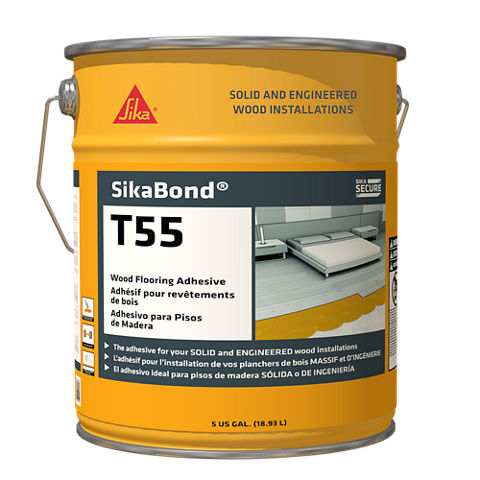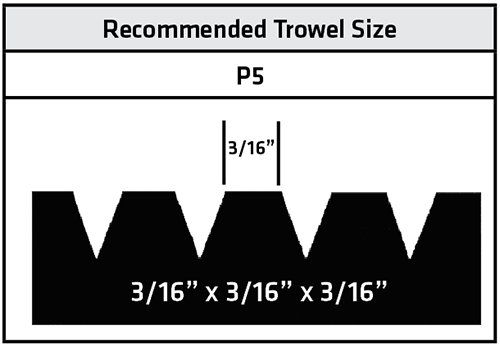Preparation is a critical step in the installation process and will ensure a successful, long-term, tenacious bond. Substrates must be structurally sound, clean, dry, level, free of voids, projections, loose materials. They must be free of oil, grease, sealers or any contaminants or conditions that may affect adhesion or overall product performances. They should be thoroughly cleaned with an industrial vacuum fitted with a brush attachment. For substrates with old, non-water soluble well-bonded adhesive or adhesive residue (other than adhesives with pressure-sensitive characteristics), use Sika® Primer MBCA. See relevant Product Data Sheet for application instructions and proper details.
SikaBond®-T55 can generally be used without priming on properly prepared, structurally sound - concrete, cement floors, chipboards, ceramic tiles, plywood and hardwood. For on-grade sub-floors Sika recommends the use of Sika® Primer MBCA for best protection against sub-floor moisture For best results with the wood flooring products, moisture testing is required by the wood flooring manufacturer. Below grade applications are generally not recommended unless proper precautions are taken to protect the wood flooring from extremes of sub-floor and in-room humidity.
For application over ceramic tiles, it is necessary to grind tile surfaces, removing any glaze and producing a matt, fine gripping surface and then clean thoroughly with an industrial vacuum with a brush attachment.
If surface contains asphalt (cutback) adhesive, follow the Resilient Floor Covering Institute’s “Recommended Work Practices” for removal. When the asphalt (cutback) adhesive is sufficiently removed, use the Sika® Primer MBCA to help promote adhesion to the sub-floor, or use a Sika Level primer and levelling compound over the cutback residue. SikaBond®-T55 will adhere to most common patching/levelling compounds. Due to differences in asphalt based adhesive types and performance capabilities; applicator must verify that preparation of the surface is sufficient prior to using Sika® Primer MBCA or the Sika Level compound. For unknown substrates, contact your Sika Canada Technical Sales Representative.
Substrate Temperature: During laying and until SikaBond®-T55 has fully cured, substrate temperature should be greater than 15 °C (59 °F) and in case of in-floor heating systems, less than +20 °C (68 °F). For substrate temperatures, the standard construction rules are relevant.
Air Temperature: Room temperature must be between +15 °C (59 °F) and +32 °C (90 °F). For ambient temperatures, the standard construction rules are relevant. Follow all wood floor manufacturer’s acclimation and room temperature requirements.
Substrate Humidity: Moisture requirements are set forth to protect wood flooring products that can expand and contract with different moisture levels in the room. SikaBond®-T55 is not affected by moisture or vapour transmission. The guidelines below are included to provide the best practices in moisture vapour testing that exists today. Permissible substrate moisture contents are listed below:
| Application | Moisture level requirements using Tramex method (%) |
| 19 mm (3/4 in) solid or engineered wood over concrete | 4 % |
| 19 mm (3/4 in) solid or engineered wood over concrete with Sika® Primer MBCA layer | 6 % |
| 19 mm (3/4 in) solid or engineered wood over in-floor heating over concrete | 3 % |
The NWFA (National Wood Flooring Association) recommends the use of moisture testing devices that identify actual moisture content in percentages (%). For best results in measuring the moisture levels in cement based sub-floors, use a Tramex moisture meter to find the highest reading in the application area. As a general guideline for floors with no in-floor heating, if the Tramex reading is below 4 %, the Sika® Primer MBCA will not be necessary; and between 4 % and 6 %, Sika® Primer MBCA will be required. For moisture content and quality of substrates, the wood floor manufacturer’s guidelines should be observed.
Relative Air Humidity: Between 40 % and 70 %


